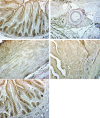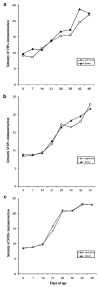Secretion of immunomodulating neuropeptides (VIP, SP) and nitric oxide synthase in porcine small intestine during postnatal development
- PMID: 23027346
- PMCID: PMC3493976
- DOI: 10.4081/ejh.2012.e30
Secretion of immunomodulating neuropeptides (VIP, SP) and nitric oxide synthase in porcine small intestine during postnatal development
Abstract
Immunohistological identification/localization of immunomodulating neuropeptides [vasoactive intestinal polypeptide (VIP) and substance P (SP)] and enzyme nitric oxide synthase (NOS) as well as histomorphometric analyses of kinetics of their release and development of respective nerve fibers density during postnatal ontogenesis of porcine intestinal mucosal immune system (IMIS), were performed in order to assess the role of these molecules involved in maturation of the IMIS. The kinetcs of reactions to VIP, SP and NOS were demonstrated in the samples of jejunum and ileum from conventionally reared pigs. The samples were obtained at 0, 7, 14, 21, 28, 35, 42 and 49 days of age and processed for immunohistological staining. The VIP+ reaction was prevalently visible in the epithelial layer, lamina propria and Lieberkühn crypts (Lc) but also in the submucosa and lamina muscularis along blood and lymphatic vessels. The SP+ fibers were regularily distributed along enteric neurons in the muscular layer. The reaction to NOS was demonstrated in both mucosa and submucosa of ileum and jejunum and in the ileal Peyer's patches (PP). Intensity of the reaction was more pronounced in the epithelial layer and numerous NOS+ cells were observed around the Lc and inside the follicles of the PP. Also, we have noticed NOS+ blood vessels, particular neurons and nerve fibers in the submucosa and muscular layer of the small intestine. By analyzing quantitative patterns of SP+, VIP+ fibers and release of NOS we have concluded that intensity of their reactions gradually increases with age, except a short period of stagnation after weaning (at age of 28 days), reaching the highest values in the pigs aged between 42 and 49 days. The values obtained by Sperman rank order correlation test (rs) between days of age of pigs and intensity of the reactions in their jejunum/ileum to VIP (rs=0.97/0.95), SP (rs=0.97/0.97) and NOS (rs=0.98/0.95), respectively, showed positive correlations (P<0.05) according to Roemer Orphal scale. Current study showed that postnatal development of porcine IMIS was accompanied by a substantial increase in the secretion of neuropeptides/enzyme tested and that these molecules may participate in the functional maturation of immunoregulatory/bactericidal mechanisms of the local (intestinal) immune defense in young pigs.
Figures




Similar articles
-
Immunolocalization of NOS, VIP, galanin and SP in the small intestine of suckling pigs treated with red kidney bean (Phaseolus vulgaris) lectin.Acta Histochem. 2013 Apr;115(3):219-25. doi: 10.1016/j.acthis.2012.06.010. Epub 2012 Jul 20. Acta Histochem. 2013. PMID: 22819292
-
Neurohormonal peptides, serotonin, and nitric oxide synthase in the enteric nervous system and endocrine cells of the gastrointestinal tract of neotenic and thyroid hormone-treated axolotls (Ambystoma mexicanum).Cell Tissue Res. 1999 Jul;297(1):91-101. doi: 10.1007/s004410051336. Cell Tissue Res. 1999. PMID: 10398886
-
Immunohistochemical localization of peptidergic nerve fibers and neuropeptide receptors in Peyer's patches of the cat ileum.Regul Pept. 1994 Dec 15;54(2-3):385-95. doi: 10.1016/0167-0115(94)90536-3. Regul Pept. 1994. PMID: 7536334
-
Ultrastructural localization of nitric oxide synthase in canine small intestine and colon.Am J Physiol. 1994 Apr;266(4 Pt 1):C981-9. doi: 10.1152/ajpcell.1994.266.4.C981. Am J Physiol. 1994. PMID: 7513956
-
Catecholaminergic, cholinergic and peptidergic innervation of gut-associated lymphoid tissue in porcine jejunum and ileum.Cell Tissue Res. 1999 Nov;298(2):275-86. doi: 10.1007/s004419900096. Cell Tissue Res. 1999. PMID: 10571116
Cited by
-
Influence of polyethylene terephthalate (PET) microplastic on selected active substances in the intramural neurons of the porcine duodenum.Part Fibre Toxicol. 2024 Feb 6;21(1):5. doi: 10.1186/s12989-024-00566-w. Part Fibre Toxicol. 2024. PMID: 38321545 Free PMC article.
-
Mycotoxins and the Enteric Nervous System.Toxins (Basel). 2020 Jul 19;12(7):461. doi: 10.3390/toxins12070461. Toxins (Basel). 2020. PMID: 32707706 Free PMC article. Review.
-
Impact of Histochemistry on biomedical research: looking through the articles published in a long-established histochemical journal.Eur J Histochem. 2014 Dec 30;58(4):2474. doi: 10.4081/ejh.2014.2474. Eur J Histochem. 2014. PMID: 25578981 Free PMC article.
-
On the future contents of a small journal of histochemistry.Eur J Histochem. 2012 Dec 10;56(4):e51. doi: 10.4081/ejh.2012.e51. Eur J Histochem. 2012. PMID: 23361247 Free PMC article.
-
Histochemistry as an irreplaceable approach for investigating functional cytology and histology.Eur J Histochem. 2013 Dec 19;57(4):e41. doi: 10.4081/ejh.2013.e41. Eur J Histochem. 2013. PMID: 24441194 Free PMC article.
References
-
- Rothkötter HJ, Sowa E, Pabst R. The pig as a model of developmental immunology. Hum Exp Toxicol. 2002;21:533–6. - PubMed
-
- Bienenstock J, Croitoru K, Ernst PB, Stead RH, Stanisz A. Neuroendocrine regulation of mucosal immunity. Immunol Invest. 1989;18:69–76. - PubMed
-
- Theodorou V, Fioramonti J, Bueno L. Integrative neuroimmunology of the digestive tract. Vet Res. 1996;27:427–42. - PubMed
-
- Kimata H, Fujimoto M. Vasoactive intestinal peptide specifically induces human IgA1 and IgA2 production. Eur J Immunol. 1994;24:2262–5. - PubMed
-
- Delgado M, Abad C, Martinez C, Juarranz MG, Arranz A, Gomariz RP, et al. Vasoactive intestinal peptide in the immune system: potential therapeutic role in inflammatory and autoimmune diseases. J Mol Med. 2002;80:16–24. - PubMed
Publication types
MeSH terms
Substances
LinkOut - more resources
Full Text Sources
Miscellaneous

